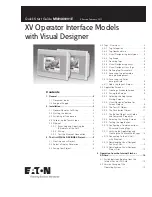
5
Quick Start Guide
MN0480001E
Effective February 2011
XV Operator Interface Models
with Visual Designer
eaton Corporation
www.eaton.com
3.4.1 Tag Categories
Visual Designer defines three (3) different tag categories within an
application. These are:
Project tags
•
are tags you can create during application develop-
ment. Example where application tags are used include:
Displays
•
Tags that read from/write to field equipment
•
Control tags
•
Auxiliary tags used to perform mathematical calculations
•
System tags
•
are predefined tags with predetermined functions
that are used within Visual Designer’s supervisory tasks. Most
system tags are read-only. Example system tags include
Date tags, which holds the current date in string format
•
Time tags, which holds the current time in string format.
•
System tags do not count against the Visual Designer application
ote:
N
tags license limit
Shared tags
•
are created in certain PC-based control software
programs and imported into Visual Designer. You cannot modify
these tags within Visual Designer, but you can modify these tags
in the PC-based control software, then you can update and use
them in the Visual Designer Application database.
Shared tags do not count against the Visual Designer
ote:
N
application tags license limit
Shared tags are not used with CoDeSys or MXpro, they are
ote:
N
imported with the CoDeSys Tag import wizard from the .SYM
file created by MXpro.
All tag definitions are found in folders located in the Global Tab of the
Visual Designer Workspace. Project tags are declared in the Project
Tags database folder.
3.4.2 Tag Nomenclature
When defining application tags, you must adhere to the following
syntax rules:
You must begin the tag with a letter. After that, you can use any
•
combination of letters, numbers, and the underscore character (_).
You can use a maximum of 32 characters (for a tag name) or 16
•
characters (for a class member name).
Prohibited symbols in the tag name are ` ~ ! @ # $ % ^ & * ( ) - =
•
\ + / [ ] { } < > ? , .
Application tag names must be unique from all other tag names
•
and Visual Designer built-in function names
You can use upper- or lowercase letters in a tag name. Tag names
are not case sensitive, and you can use both upper and lower-
case characters to make tag names more readable (for example:
TankLevel instead of tanklevel).
3.4.3 Visual Designer tag data types
Visual Designer allows you to define the following standard
tag value types:
Boolean (One Bit):
A digital value of 0 or 1 representing
False or True.
Integer (Four bytes):
Signed integer number (positive, negative, or
zero). Equivalent to the C-type signed long integer. (with a range of
–2147483647 to 2147483647).
Real (Floating point, eight bytes):
Real number internally
stored as a double word. Equivalent to the C-type double precision
floating point.
String (alphanumeric data, up to 1024 chars):
Character string
up to 1024 characters (from 0 to 1023) that holds letters, numbers,
or special characters. Visual Designer supports both ASCII and
UNICODE characters.
Array:
An array tag is a set of tags of the same data type, with the
same name, that use an index to uniquely identify an item. Visual
Designer supports 1-dimension arrays only at this time.
Class:
A class tag is a compound tag type that has been defined by
a class template. A class template can consist of one or more data
types. Class tags are helpful when developing applications that have
items (e.g. tanks) that have multiple properties being monitored or
controlled (e.g. fill level, temperature, pressure).
Pointer:
A pointer tag lets you indirectly refer to another tag in the
Visual Designer database.
3.4.4 Tag Scope
All tags have Scope, the Scope types being either Server or Local.
If a tag is defined as having Server Scope, this means that the tag
is accessible both to the local XV unit (that is executing the Visual
Designer application runtime) and to any Web Thin Clients connected
to the local XV unit (called the Server). If a tag is defined as having
Local Scope, this means that the tag is only accessible (usable or
viewable) from each local device (the Server or the Web Client). In
other words local tags have separate instances in the server and in
the client and can contain different data. An example of a local tag
would a tag that is used to determine the current language selec-
tion. Another example would be the system tag Time which may be
different if the Client and Server were in different time zones over a
corporate network.
3.4.5 Declaring Tags
To declare a tag, you open the Project Tags folder, Datasheet View in
the Global Tab of the Workspace. This is where all Project tags can
be declared. In the Name field, you enter a unique tag name. In the
Type combo box, click on the down button and select the tag type
(Boolean, Integer, Real or String). An optional Description field is pro-
vided to allow for a short description of the tag to be entered. The
Scope field allows for setting of the tag scope (Server or Local). The
Size field defaults to 0, meaning the tag is a single (non-array) tag. If
the value in the Size field is greater than 0, this defines a tag array
(discussed further in the section below).


































